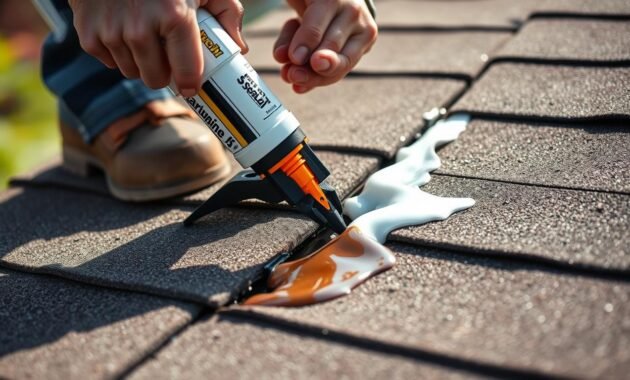Roof leaks can turn your peaceful home into a nightmare. Water dripping through your ceiling creates stress, damage, and unexpected repair costs. Many homeowners struggle to find an affordable flex seal for roof solution that works.
Traditional roof repairs often require expensive professional services or complex DIY techniques. The frustration of repeated leaks and mounting expenses drives people to seek alternative methods like flex seal roof repair products. I’ll help you understand if this popular solution can truly seal roof leak problems effectively.
Read also: Flex Seal for Roof: Is It Working Effectively?

This guide will dive deep into the practical applications, benefits, and realistic expectations of using Flex Seal for roof maintenance. Let’s explore whether this product can be your home’s saving grace or just another temporary fix.
Understanding Flex Seal and Its Roofing Applications
Fixing roofs can be tough, but Flex Seal liquid is a great solution for small damage. It’s a rubberized coating that quickly fixes many roofing problems. This makes it a favorite among homeowners.
What Is Flex Seal Liquid Rubber?
Flex Seal liquid is a special coating that makes surfaces waterproof. It turns from liquid to rubber, sealing cracks and stopping water. It comes in different forms to fit various repair needs.
Read also: Guide on How to Seal a Flat Roof Leak
Common Roofing Problems Addressed
- Small roof leaks
- Hairline cracks
- Seam separations
- Pipe and vent penetration gaps
Available Product Forms for Roof Application
| Product Type | Application Method | Best Used For |
|---|---|---|
| Flex Seal Spray | Spray directly on surface | Quick coverage of small areas |
| Flex Seal Liquid | Pour, brush, or roll | Large surface repairs |
| Flex Seal Paste | Hand application | Filling deeper gaps |
Choosing the right Flex Seal product is key for your roof repair. Knowing the differences between each type ensures the best fix. This way, your roof stays protected for a long time.
The Truth About Using Flex Seal for Roof Leaks

Many homeowners use Flex Seal to fix roof leaks. I’ve looked into how well it works. Flex Seal can offer temporary relief but isn’t a lasting fix for big roof issues.
Here’s what Flex Seal can and can’t do for roof damage:
- Works best for small, minor roof leaks
- Provides temporary water resistance
- Not suitable for extensive structural roof damage
- Requires clean, dry surface for proper application
I suggest using Flex Seal only for emergency repairs. It’s a temporary fix that can stop water for a while. Roofers say to use Flex Seal only in these cases:
- Tiny pinhole leaks
- Small cracks around roof penetrations
- Temporary sealing before professional repair
But, Flex Seal has big limitations for roof leaks. It can’t replace professional fixes for major damage. It might hide problems, leading to more costly repairs later.
| Roof Leak Scenario | Flex Seal Effectiveness |
|---|---|
| Small Crack | Good Temporary Solution |
| Large Structural Damage | Not Recommended |
| Ongoing Water Intrusion | Ineffective Long-Term |
My advice? Use Flex Seal with caution. It’s okay in emergencies, but always get a pro for real roof repairs.
How to Apply Flex Seal on Your Roof
Fixing roof leaks can be tough, but Flex Seal makes it easy for homeowners. I’ll show you how to use Flex Seal to keep your roof safe and dry.
Surface Preparation Requirements
Getting your roof ready for Flex Seal is the first step. Here’s what to do:
- Clean the roof surface thoroughly
- Remove dirt, debris, and loose materials
- Ensure the surface is completely dry
- Check for any existing damage that might need additional repair
Application Techniques and Tools
Choose the right way to apply Flex Seal based on its form:
| Product Type | Application Method | Recommended Tools |
|---|---|---|
| Spray | Even, sweeping motions | Spray nozzle, protective gloves |
| Liquid | Brush or roller application | Foam brush, paint roller |
Drying and Curing Time Guidelines
Be patient when using Flex Seal. Wait for the first coat to dry before adding more. It usually takes 24 to 48 hours. Thin coats work better than thick ones.
- Apply first coat evenly
- Allow 24 to 48 hours for complete drying
- Check for any missed spots
- Apply additional coats if necessary
By following these steps, you’ll get the most out of your Flex Seal roof repair. Your home will stay safe from water damage.
Flex Seal for Roof: Advantages and Limitations
When thinking about using flex seal for roof repairs, it’s important to know its good points and downsides. As someone who has tried different roof repair options, I’ve found that flex seal can be a fast fix. But it’s not the best answer for every roofing problem.
Here are the main benefits of using flex seal on your roof:
- It’s cheaper than hiring a pro for roof repairs
- It’s simple to use for small leak fixes
- It dries fast and keeps water out
- You can use it on many types of roofs
But, roof tar and professional repairs often last longer. Flex seal is best for small cracks and temporary fixes, not big roof problems.
Here are some key things to keep in mind:
- It’s not good for big roof repairs
- It might not work well with all roof materials
- It doesn’t last long in harsh weather
- It might not stop leaks for good
I suggest checking the damage first. For small leaks and quick fixes, flex seal is a great DIY choice. But for big roof damage, it’s best to get a pro’s help.
Impact on Roof Warranties and Long-term Effects
Using Flex Seal to fix roof leaks can have big effects on your roof’s warranty. It might cause problems with your warranty coverage.

Roof warranties protect you from material defects and installation issues. Using Flex Seal without a pro’s help could void these protections.
Warranty Voiding Risks
- Manufacturer warranties may become invalid after DIY repairs
- Roofing contractors could refuse future service claims
- Potential complete loss of existing roof coverage
Read also: Best Methods of Attaching a Roof to an Existing Roof
Material-Specific Considerations
Different roofing materials react differently to Flex Seal. Asphalt shingles, metal roofs, and rubber membranes each have unique traits.
Before trying to fix roof leaks yourself, check your warranty. Talking to a roofing expert can help you avoid risks and find the best fix for your roof.
Cost Comparison: Flex Seal vs Traditional Roof Repairs
Roof repairs can be expensive. Homeowners often look for cheaper alternatives to fix leaks. Let’s compare the costs of Flex Seal and traditional roof repairs.
Professional roof repairs can cost thousands. A full roof replacement is between $5,000 and $10,000. On the other hand, Flex Seal can cost under $100 for a basic fix.
| Repair Method | Average Cost | Durability |
|---|---|---|
| Professional Roof Replacement | $6,000 – $10,000 | 15-25 years |
| Professional Roof Repair | $500 – $1,500 | 5-10 years |
| Flex Seal Roof Repair | $50 – $200 | 1-3 years |
When thinking about using Flex Seal for roof repairs, remember these points:
- Initial costs are much lower
- You might need to apply it more than once
- Ignoring damage can lead to bigger problems later
I suggest using Flex Seal for small leaks. But for big damage, professional repairs are safer. Always check how bad the damage is before choosing a fix.
When to Choose Professional Repairs Over DIY Flex Seal
Fixing a roof leak can be tough. Flex Seal might seem like an easy fix, but not all problems can be solved at home. Some issues need a pro to avoid more damage and keep your home safe.
Knowing when to call a pro is key to keeping your roof in good shape. Some signs mean you need more than just Flex Seal.
Signs of Major Roof Damage
Here are signs that mean you should get a pro:
- Large cracks over a few inches
- Big damage around roof edges
- Leaks in different parts of the roof
- Sagging or warped roof decking
- Water stains on ceilings or walls
Safety Considerations for DIY Repairs
Fixing your roof can be very dangerous. Most homeowners aren’t ready for these risks. Roofers have the right gear and know-how to stay safe on steep roofs.
- Proper fall protection gear
- Specialized climbing and safety techniques
- Knowledge of structural load-bearing limitations
- Insurance and liability coverage
If you see any of these signs, get a pro roofing contractor. While Flex Seal works for small leaks, big damage needs a pro to keep your home safe.
Weather Resistance and Durability Factors
When you think about using flex seal for roof repairs, knowing its weather resistance is key. My research shows that its durability changes a lot depending on the weather. If you’re trying to fix a roof leak, it’s important to understand how well this solution works in harsh weather.
Flex Seal is very tough in many weather conditions. Its liquid rubber formula makes a strong barrier. It can handle big temperature swings, from very hot to very cold. It also stands up to UV rays, heavy rain, and strong winds.
- Heat resistance up to 120°F
- Cold tolerance down to 0°F
- Water-resistant coating that prevents moisture penetration
- Flexible membrane that expands and contracts with temperature changes
The climate where you live affects how long your flex seal will last. In places with mild weather, it can protect your roof for years. But in harsher climates, you might need to apply it more often to keep it working well.
Roofing pros say to check your roof seal every year, more often after bad weather. This helps find any weak spots early. It keeps your roof safe from leaks.
Conclusion
Exploring Flex Seal for roof repairs shows it’s not for every situation. It can fix small leaks quickly, but it’s not a permanent fix. Knowing its limits is key.
Homeowners should think carefully before using Flex Seal. It works for small issues, but big problems need a pro. Use it as a temporary fix until a pro can check your roof.
Keeping your roof in good shape is the best way to avoid big problems. Regular checks can save you a lot of money. If you use Flex Seal, make sure to apply it right and watch for leaks.
Keeping your home safe is the most important thing. Flex Seal is helpful, but it can’t replace a pro’s work. Always choose solutions that keep your roof strong and your home safe.




